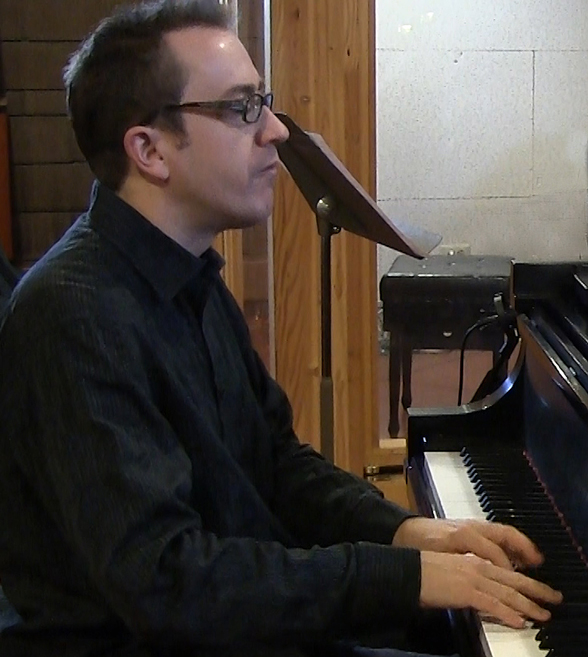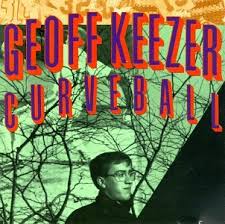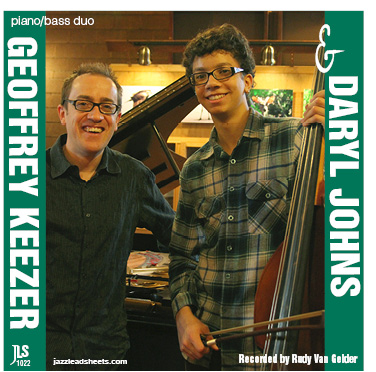Jackleg Patrol – Geoffrey Keezer
This song from Keezer's second album as a leader is a challenging rhythm section workout, especially for the bass. We have an exclusive duo recording of Keezer with young bass star Daryl Johns, with a somewhat different arrangement; a transcription of the piano solo from this recording is available.
- Recording: Geoff Keezer - Curveball
- Recorded on: June 22, 1989
- Label: Sunnyside Communications (SSC 1045)
- Concert Key: No key center
- Vocal Range: , to
- Style: Swing (medium up)
- Vibes - Steve Nelson
- Piano - Geoff Keezer
- Bass - Charnett Moffett
- Drums - Victor Lewis
Video
- Description
- Historical Notes
- Solos
- Piano Corner
- Bass Corner
- Drum Corner
- Guitar Corner
- Inside & Beyond
- Minus You
The following C section is also eight measures, and introduces some angular triplet bass figures answered by simple melody phrases on overlaid Gmaj7 and Amaj7 chords. Then there's a six-measure D section whose melody suggests a D♭ major tonality, but is harmonized in mostly root position maj7♯5 chords coming to rest on F7/G♭. The final E section of the head is the same as A.
The bass finally walks on the solos, which keep the ten-measure A section form from the head. The slash chords at the end of this section are changed to sus chords on the roots, resolving to E♭maj7 instead of E♭/A♭. One chord is held on the first six measures of this section: F♯7 with a natural and sharp 5th. (Don't be confused by this natural—these two chord tones are C♯ and D, not C and C♯.) It's essentially an inversion of Dmaj7♯5, and comes from the B melodic minor scale. The rest of the solo form is a new eight-measure bridge with more II-V7-based harmonies, followed by eight measures of G7/D♭.
There is an intro which is one A section long, featuring the same bass line from the A section but developed into a more complex figure in the seventh and eighth measures. The coda again vamps on the same F♯7 tonality from the solos, with the last four measures of the intro on cue at the end.
On this recording, the bass line is doubled by the piano. Our Concert Condensed Score is the rhythm section part for this arrangement. On the recording the vibes have two-note harmonies on the B section, which are notated in this score. A solo piano arrangement is available; click on Piano Corner for more details.
Related Songs
Email Send Jackleg Patrol to a friend
- Recording: Geoffrey Keezer - Geoffrey Keezer - Daryl Johns Duo
- Recorded on: December 18, 2011
- Label: jazzleadsheets.com (JLS 1022)
- Concert Key: No key center
- Vocal Range: , to
- Style: Swing (medium up)
- Piano - Geoff Keezer
- Bass - Daryl Johns
- Description
- Historical Notes
- Solos
- Piano Corner
- Bass Corner
- Drum Corner
- Guitar Corner
- Inside & Beyond
- Minus You
Between the piano and bass solos, some of the head is played as an interlude: the B and C sections and the first four measures of the D section, which go straight into the same solo form for the bass. The out head is taken from B, with no vamp for the coda but instead two more chords continuing the last phrase of the head. Because both the interlude and out head start on B, our parts indicate D.S. after each solo; "to Bass solo" is written at the fourth measure of the D section.
A bass part is available. We also have a transcription of Geoffrey's piano solo; click on the Solos tab for more details.
When Don Sickler met Daryl Johns at the 2009 Thelonious Monk International Bass Competition, he saw great possibilities in the young man. Only 13 years old at the time, Daryl so impressed the judges that he got special mention. Don envisioned a series of bass-feature recordings, with Daryl alongside some of Don's Second Floor Music pianist/composers. With the recording expertise of Rudy Van Gelder, over the next few years eight sessions were completed. Check out our Piano/Bass Duos.
Related Songs
Email Send Jackleg Patrol to a friend

Geoffrey Keezer
born on November 20, 1970
A lauded name on the jazz scene since the tender age of 17, Geoffrey Keezer is a native of Eau Claire, Wisconsin. Geoff took up the piano at age three and quickly showed himself to be a prodigy. As an eighteen-year-old freshman at Berklee College of Music in 1989, he was invited to join Art Blakey's Jazz Messengers, launching his talents into the spotlight. The year before, his mentor James Williams encouraged him to record his debut album, the well-received "Waiting In The Wings." His career continued to take off in the early 1990s with a performance at the Hollywood Bowl of Gershwin's Rhapsody In Blue (conducted by John Mauceri). Read more...




